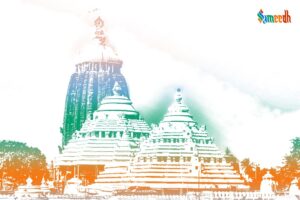The Jagannath Temple in Puri, Odisha, India, is surrounded by various mysteries and legends, contributing to its mystique and cultural significance. While some aspects are based on religious beliefs and myths, others involve historical and architectural enigmas.

The “Jagannath Temple” refers to the famous Jagannath Puri Temple in Puri, Odisha, India. The temple is dedicated to Lord Jagannath, a form of the Hindu deity Vishnu, along with his siblings Balabhadra and Subhadra. The temple is an important pilgrimage site for Hindus and is known for its annual Rath Yatra (chariot festival) during which the deities are taken out in grand processions.
It is also believed that when the Pandavs started their journey to Yamraj, Sapt Rishis advised them to visit the ‘Char Dham’ to get closer to ‘moksh.’ And, Jagannath Temple in Puri is one of holy places of ‘Char Dham.’
The mystery surrounding the Jagannath Temple primarily revolves around its origin and the secret inner sanctum known as the “Garbhagriha.” Some aspects of the temple’s history and construction remain unclear, leading to various myths and legends. Here are some aspects that contribute to the mystery:
- Secrets of Construction: The exact construction techniques and engineering marvels employed in building the Jagannath Temple remain a mystery. The temple’s architecture, including the construction of the main spire and the synchronization of rituals with celestial events, is not fully documented.
- The Direction of Sudarshan Chakra – The chakra is actually 20 ft high and weighs a ton. It is fitted on top of the temple. But what is interesting about this chakra is that, you can see this chakra from any corner of the Puri city. The engineering mystery behind the placing and positioning of chakra is still a mystery because irrespective of your position, you can always feel that the chakra is facing toward you.
- Nilachakra and Shadowless Spire: It is said that the temple’s main spire, called the “Nilachakra,” does not cast a shadow at any time of the day. The reason behind this phenomenon is unknown and adds an element of mysticism to the temple.
- Changing Flag Direction: There is a belief that the flag (Dhvaja) on top of the temple changes its direction, rotating in the opposite way. The flag floating in opposite direction brings your scientific reasoning to a halt, and you just tend to believe that there is some force more powerful than science. This is often considered a divine occurrence, though it is more likely a symbolic representation rather than a scientifically observed phenomenon.
- Nabakalebara Rituals: The deities in the temple are made of wood and are replaced every 12 or 19 years, depending on the lunar calendar. The ritual of replacing the deities, known as “Nabakalebara,” involves a series of complex ceremonies and calculations. The selection process for the sacred neem trees from which the new deities are carved is also considered mysterious. The selection of the sacred neem trees and the intricate ceremonies surrounding this event are considered mysterious.
- Preparation of Mahaprasadam – The Mahaprasad is prepared by thousands of priests and
7 earthen pots are placed one above the other and the food is cooked over firewood and the food in the topmost pot gets cooked first followed by the rest. This is another riddle to solve. - Sound of Waves – Once you step inside the temple, you stop hearing the sound of the sea. According to myth, Goddess Subhadra wished that the temple would be a place of serenity, and in order to please her, the temple mutes the sound of the sea.
- No planes, no birds fly above the temple – Surprisingly, to know that no birds or planes fly above the temple. By contrast, such an aspect is a rarity at any other temple in India. The site is a no-fly zone actually, which has not been declared by any state powers, but by some divine power. This phenomenon also apparently has no explanation. It still remains a mystery.
- Magnetic Properties: Some legends suggest the use of magnets in the construction of the temple, but the specifics of such alleged magnetic properties remain unclear and speculative.
- Prohibited Entry to Non-Hindus: The inner sanctum of the temple, where the main deities reside, is off-limits to non-Hindus. The exact rituals conducted inside are not disclosed to the public, adding an air of mystery to the inner workings of the temple.
- Legends of Origin: The temple has several myths and legends surrounding its origin, including stories about the appearance of the deity and the construction of the temple by King Indradyumna. The exact historical origins of the temple are not well-documented, contributing to the mystery.
It’s important to note that many of these mysteries are deeply rooted in religious beliefs, folklore, and the cultural history of the region. The Jagannath Temple continues to be a place of spiritual significance and cultural heritage for millions of people.